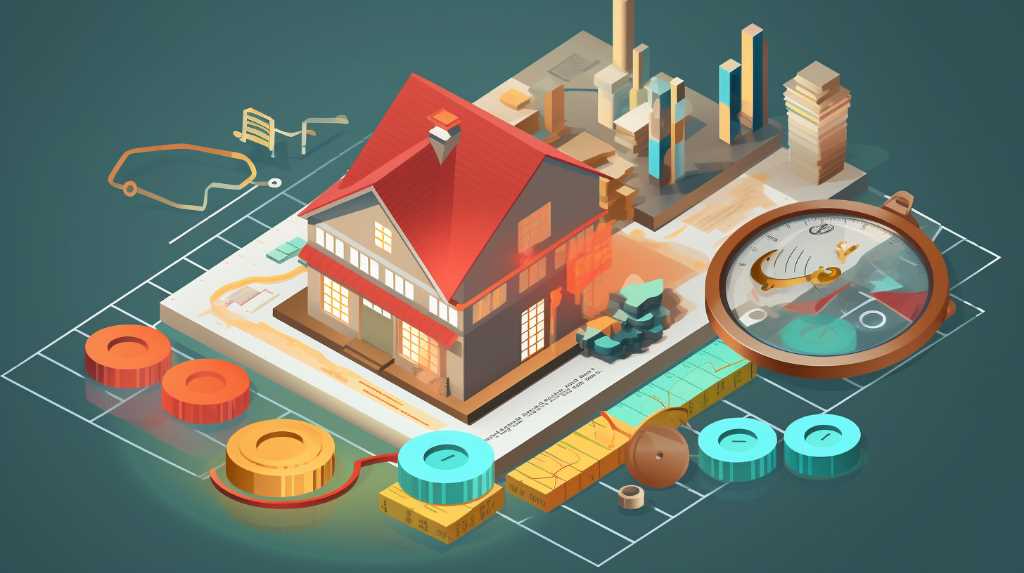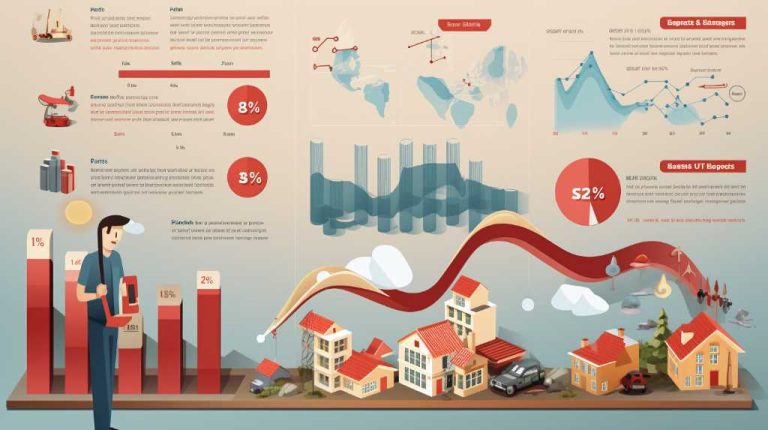Economic Indicating Factors: 5 Hidden Insights in Real Estate Cycle

As you navigate the choppy waters of real estate investment, it’s crucial to understand the undercurrents that shape the market.
These five hidden economic indicating factors are your compass, guiding you through the ebb and flow of property cycles.
You’ll discover how location doesn’t just dictate your view but also sways the value of your investment.
You’ll grasp why supply and demand aren’t just market buzzwords—they’re the heartbeat of price fluctuations.
Economic indicators, more than mere numbers, forecast the climate of your financial growth.
Interest rates, the invisible hand that can lift or suppress your portfolio’s potential, demand your attention.

Lastly, don’t overlook demographic shifts; they’re the silent movers of market trends.
Unlocking these secrets arms you with the knowledge to chart a course to freedom and prosperity.
Market Prediction Insights
https://www.youtube.com/watch?v=2kBiwZEoVvs
You’ll need to consider several key economic indicators to accurately predict the real estate market’s direction. Interest rates are a crucial piece of the puzzle. When they’re low, they beckon you to the market, increasing housing demand and, subsequently, real estate prices. Conversely, when rates climb, they might nudge you to pause, potentially cooling the market. It’s a dance of supply and demand, with each step influenced by broader economic conditions.
Keep an eye on government policies as well, as they can either liberate or restrain your market moves. Initiatives promoting homeownership can unleash a surge in demand, while stricter regulations might do the opposite. You’re not just buying property; you’re navigating economic factors that shape the value of your investment.

Economic indicators like job growth rates and GDP also signal market conditions. In times of prosperity, office and retail spaces thrive, pushing up property values. But when the economy contracts, the ripple effects can leave you with lower rental income and reduced property values. To stay ahead, you must track these economic indicators and adapt to the ebb and flow of the market.
Investment Strategy Analysis
While considering your next move in real estate investment, it’s essential to analyze how less obvious economic indicators, such as consumer spending trends and infrastructure development, can impact market cycles and your strategy. Recognizing the right investment opportunities hinges on understanding these hidden signals. They’re the roadmap to economic growth, which often translates into job creation and a robust property market.
Your investment strategy analysis should include an assessment of how rising consumer confidence might lead to increased spending and, in turn, bolster demand for retail and residential spaces. This can drive up occupancy rates and accelerate price growth, offering the potential for substantial returns. Keep a close eye on mortgage rates too; they’re a pulse on the market’s heart, affecting affordability and influencing buyer activity.
Stay ahead by considering how infrastructure projects can catalyze local markets, attracting new residents and businesses. This can be a clear sign of upcoming growth, making it a pivotal moment to seize investment opportunities before they become common knowledge.

Align your real estate investment decisions with these nuanced indicators. They’ll guide you to freedom from the constraints of traditional market analyses, providing a competitive edge in a constantly shifting landscape.
Economic Trends Impact
Examine how subtle shifts in economic trends can ripple through the real estate market, altering property values and investment potential. As you navigate the currents of the housing market, it’s crucial to acknowledge that economic downturns often dampen the enthusiasm, leading to adjustments in home prices. However, during prosperous times, you’ll notice rising property values as a direct consequence of increased demand.
The real estate markets aren’t just about the number of homes sold; they’re a reflection of the broader economy’s health. When interest rates dip, they beckon you with the promise of more affordable mortgage payments, which can spur you to jump into the market, pushing prices upward. It’s a dance of supply and demand where your freedom to invest wisely can lead to significant gains.
In the current market, demographic shifts play a critical role, too. If you’re looking for opportunities, pay attention to where the next generation prefers to live and work. Economic expansion not only bolsters housing but also boosts commercial spaces, enhancing your investment portfolio’s diversity and resilience. Understanding these economic undercurrents enables you to sail ahead, turning the tides in your favor.

Risk Management Factors
Understanding the economy’s subtle cues is key to your risk management strategy in real estate investment. The real estate market is a complex beast, influenced by a myriad of conditions that can significantly impact your bottom line. You crave the freedom to make informed decisions, and for that, you need to recognize how economic downturns can suppress demand and trigger price shifts—essential for savvy property management.
Interest rates, those veiled influencers, directly affect real estate dynamics. They can shape your financial planning and risk assessment, especially in commercial real estate where margins are often tight. A rise in interest rates can cool the market; conversely, a drop can heat it up. It’s your job to stay ahead of these trends, ensuring your risk management factors are as resilient as they’re responsive.
Demographics, often silent players, also guide the ebb and flow of real estate prices. Understanding who’s buying and selling, and why, can give you an edge in anticipating market shifts.
And let’s not forget cash reserves—a lifeline in turbulent times. They empower you to weather downturns, maintaining your freedom to operate without the constraints of short-term pressures.

Property Valuation Dynamics
You’ll find that property valuation dynamics are integral to predicting real estate cycles, as they encompass several less obvious economic indicators. When you’re eyeing homes, whether new or existing, you’re not just buying a structure; you’re investing in a lifestyle that promises freedom and comfort. The desirability of a neighborhood, its amenities, and the allure of green spaces often command a premium price for properties within it. The role in shaping these prices isn’t just about location, though; it’s a complex interplay of factors.
For instance, Home Builders are acutely aware of this as they decide on the features and finishes that will make a single-family home stand out. The balance of supply and demand, with new construction tailoring to Home Buying trends, significantly sways real estate prices.
Moreover, don’t overlook how interest rates, often moving silently in the background, influence your power to purchase new homes. As the economy expands, optimism surges, and so does the value of homes, reaffirming the pivotal role of property valuation dynamics. Understanding these elements could be your key to navigating the real estate market with confidence.
Frequently Asked Questions
What Are the 4 Cycles of the Real Estate Cycle?
You’ll navigate the real estate cycle’s four stages: recovery, expansion, hyper-supply, and recession, influenced by market sentiment, interest rates, job growth, and more to maintain your financial freedom.
What Are the Five Economic Indicating Factors That Influence Real Estate Cycle?
You’re navigating a jungle of factors, but the four that’ll make or break your real estate’s value are market prediction insights, economic trends impact, risk management factors, and property valuation dynamics. Tread carefully; it’s a financial safari.
What Phase of the Real Estate Cycle Are We in 2023?
You’re navigating a 2023 real estate cycle influenced by rising interest rates, low inventory, shifting employment trends, and fluctuating market sentiment, without regard for hidden indicators like government policy or global events.
What Step of the Real Estate Cycle Generally Follows a Recession?
You’re stepping into the recovery phase post-recession—expect recovery trends, an investment surge, rising rental demand, growing consumer confidence, better credit availability, a construction rebound, market stabilization, shifting interest rates, and policy interventions. It’s your market to conquer.
Conclusion
So, what’s your next move in the real estate market? Understanding these hidden indicators gives you an edge.
By keeping an eye on local trends, balancing supply and demand, monitoring economic shifts, staying informed about interest rates, and adapting to demographic changes, you’ll navigate the cycles more skillfully.
Don’t just follow the crowd—use these insights to manage risks, make smarter investments, and accurately value properties.
It’s your turn to capitalize on the real estate rhythm.
You Might Also Like…
9 Pivotal Economic Indicators To Watch: Unlocking Real Estate Cycles








One Comment
Comments are closed.